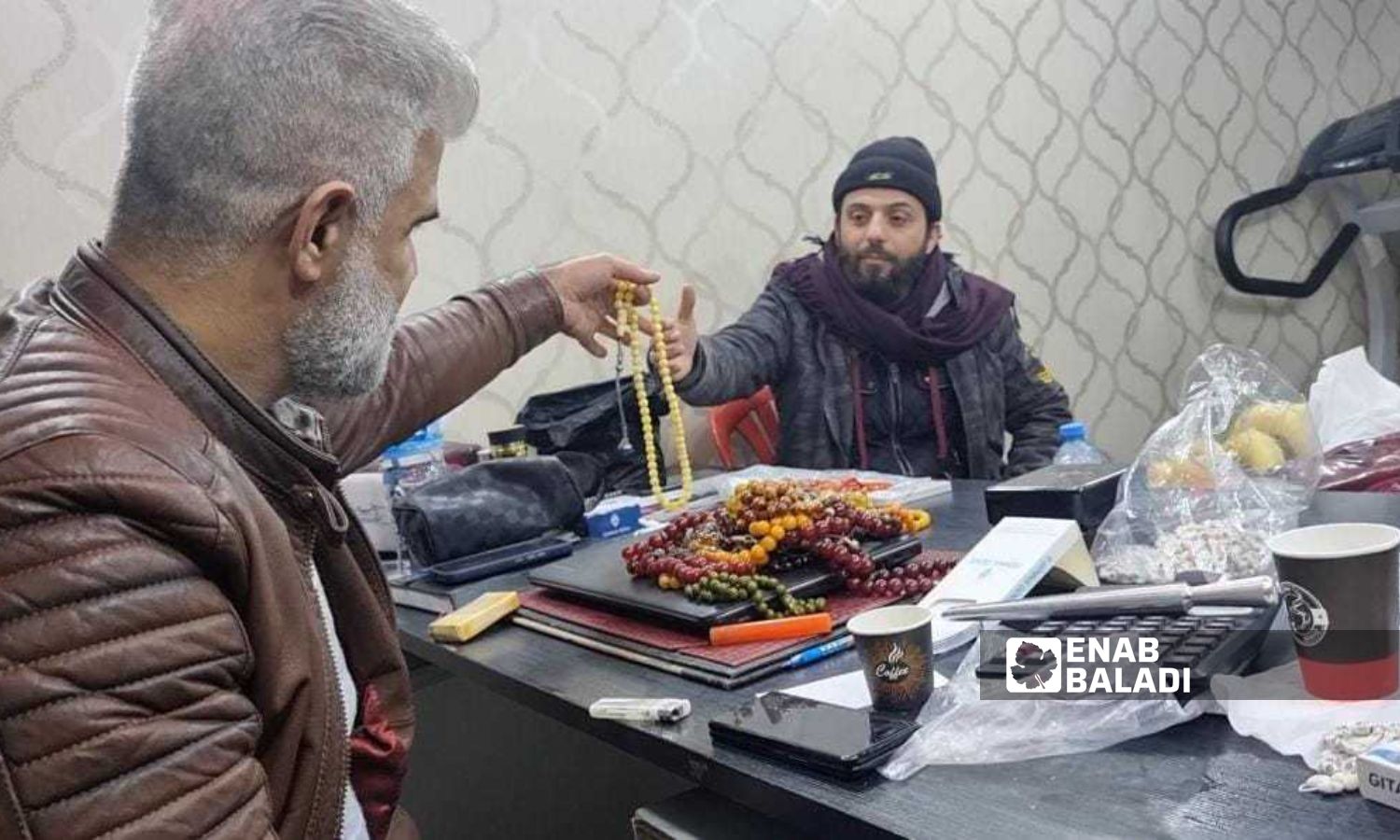



Idlib – Anas al-Khouli
While markets in northwest Syria are being flooded with plastic and polyester prayer beads, some Aleppian craftsmen are striving to preserve the traditional handmade craft by using natural raw materials despite the difficulties in importing these materials and production tools, and the absence of local markets to sell their goods.
Imad Omar (35 years old), displaced from the Shaar neighborhood in Aleppo city, inherited the craft of making handmade rosary beads from his father and has transferred this craft to where he now resides in Idlib. He is known for crafting the “sherabe” of Aleppo from silver and precious stones.
The “sherabe” is a piece of metal placed on top of the rosary bead to adorn it, and there are several types: “Istanbouli, Iraqi, Egyptian, and Aleppian.” The Aleppian “sherabe” is the most famous of these types, made completely by hand, decorated with precious stones, and known for its precise craftsmanship, heritage, and connection to the culture of Aleppo city.
Craftsman Omar told Enab Baladi that the history of the Aleppian “sherabe” dates back to over 100 years ago, since the Armenians migrated to Aleppo, where they transferred the craft to the city’s residents who initially used it to decorate household items. It then became used in the making of rosary beads.
The Aleppian “sherabe” differs from other “sherabes” in the design of the head and the flower underneath it, adorned with pieces of coral and turquoise, giving it a special beauty that is hard to replicate. According to the craftsman, this “sherabe” is used to decorate expensive rosary beads made from precious stones.
The weight of the Aleppian “sherabe” reaches 15 grams of 1000 karat silver, and the fee for its crafting ranges between 200 and 400 US dollars (the dollar exchange rate is 31 Turkish lira). The reputation of the silversmith and the level of expertise play a primary role in its price and the cost of its fabrication.
The artisan Omar relies on imported precious stones from Egypt and Tunisia for making handmade rosary beads due to the lack of local production. He faces difficulties in importing the raw materials for production and the necessary tools.
Omar mentioned to Enab Baladi that he endured the inconvenience of traveling to Istanbul and bore expenses that reached 600 dollars just to purchase a special brush for this craft, which costs only five dollars.
The precious rosary beads are usually sold in public auctions announced by traders and craftsmen, sought after by those interested in heritage and ancient pieces, amid a decline in local demand due to their high price and the general deterioration of the economic and living conditions in the region.
The craftsmen in northern Syria rely entirely on external markets and exporting to Turkey as well as several European countries where the culture of heritage rosary beads is spreading, such as Australia, Finland, and Germany, according to craftsman Omar. He pointed out that while Turkey does not officially allow the export of these pieces, traders smuggle them in and then export them.
Syrians usually distribute rosary beads on special occasions, such as when pilgrims return from performing the Hajj, as gifts for visitors. These rosary beads are mostly made of plastic, while gemstone rosaries are absent due to their high prices.
The region is experiencing a dire economic and living situation, with daily workers’ wages ranging from 70 to 100 Turkish lira (about three dollars), depending on the profession and the number of hours worked.
Ishaq Haj Omar (40 years old), involved in trading silverwares and rosary beads, told Enab Baladi that the demand in local markets is focused on the cheap commercial rosary beads made of plastic and polyester due to their low price. On the other hand, there is absolutely no local demand for heritage rosary beads.
According to the trader, the price of commercial rosary beads reaches only half a dollar, while those made from precious stones are sold based on the stones they are made from. For example, those made from African ivory start at 500 US dollars.
He added that rosary beads made from German Corba start at an auction price of $1500 and can reach up to $10,000, depending on their age and antiquity. Meanwhile, German Misky starts at $3000 and can go up to $15,000.
The trader also mentioned that these high prices for antique rosary beads prevent citizens from affording them, leading to a complete cessation of local demand. However, the demand in external markets is continuously increasing due to their heritage value.
Several crafts and industries are active in northern Syria and rely on external markets for their disposal. Most local crafts and products in Idlib face competition from imported goods, which circulate without regulatory control on their quantities entering the region. This situation causes concern for traders and craftsmen, who also complain about financial losses and threats to their livelihoods.
if you think the article contain wrong information or you have additional details Send Correction